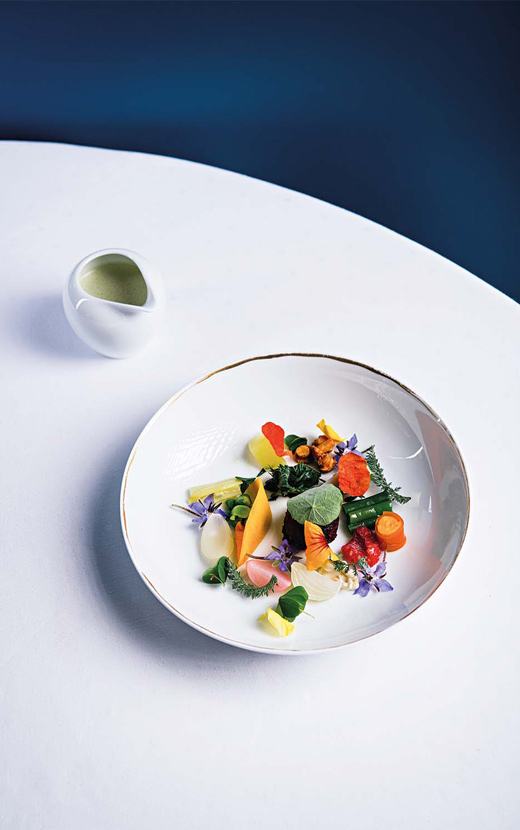
Inspiration
Must-see heritage sites to visit in and around Lake Annecy
Top 8Avoiding the summer hustle and bustle in Annecy gives the curious traveler a chance to explore the city’s heritage sites and take the time to dig deeper into the area’s unique history.
Here are 8 places you must see if you hope to learn a little more about Annecy and the surrounding area’s rich past and identity. As a bonus, enjoy the latest news for the All Saints’ Day holiday.
Annecy's Museum-Castle, a Historic Monument and place for exhibits
A must on anyone’s list of places to visit, Annecy’s castle sits on its rocky promontory throne, offering a unique perspective and great views of the roofs in old town.
The building itself, a former residence for the Count of Geneva and Duke of Genevois-Nemours, and designated a Historic Monument in 1959, is well worth the visit. The massive “Tour de la Reine” tower, which guards the entrance, and the lord’s residence are the oldest remnants of the castle. Some of the original sections date as far back as the 13th and 15th centuries. “Tour Perrière” tower, visible from Lake Annecy, includes machicolations (“drop boxes”) that really stand out, typical of this type of defensive structure that evolved over time into elegant residences influenced by Renaissance architecture. The Nemours residence offers a perfect example.
Since 1953, when the City of Annecy purchased the castle, it has served as a museum, offering both temporary and permanent exhibits from the castle’s own collection. Focusing on themes as varied as regional heritage, lakeside archeology, medieval sculpture, landscape paintings from different eras, and contemporary art, the museum has built an impressive collection of works over the years.
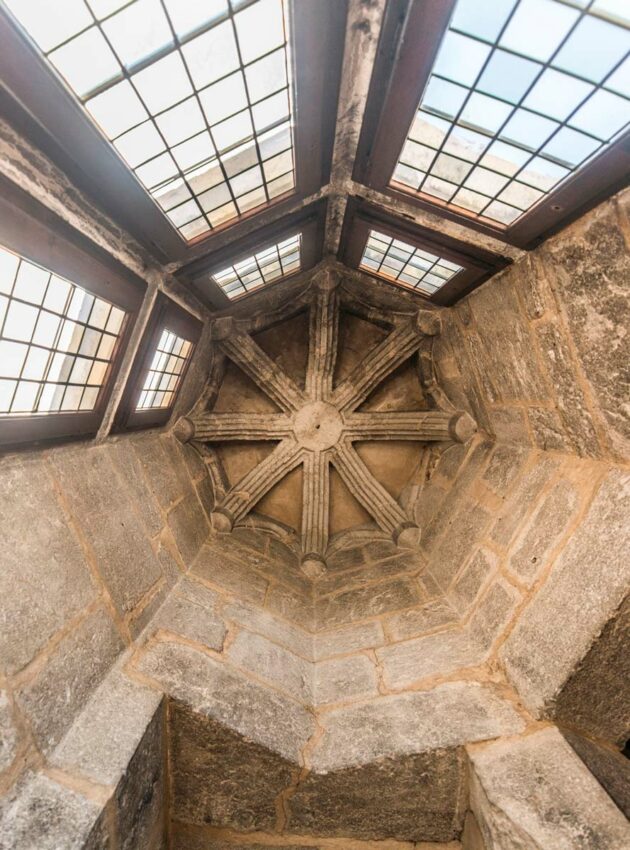
© Téo Jaffre / Annecy's Museum-Castle
Temporary exhibits offer the chance to view the castle walls in a new light. The two main events per year focus on an artist, a movement, a major facet of local heritage or history, etc.
Conferences, concerts, and animation film screenings also transform the castle into a space for showcasing the arts and creative works, where new events and new influences adorn the centuries-old stone walls.
The museum-castle recently made renovations to two of its rooms dedicated to the fine arts. One has a new layout and the other a masterpiece on loan from the local government; a painting by the legendary Pieter Bruegel II “the younger” entitled “Massacre of the Innocents”.
For more information: Annecy’s Museum-Castle
Alpine Lakes Regional Observatory (ORLA) at Annecy's Castle
Before leaving the castle’s inner ward, cross the main courtyard and pay a visit to the Alpine Lake Regional Observatory’s (abbreviated “ORLA” in French, but nothing to do with Guy de Maupassant) 700m² exhibit.
Through an interactive exhibit, the Alpine Lakes Regional Observatory educates us about lake ecosystems in the French Alps, explaining their complexity, fragility, and the environment that shapes them.
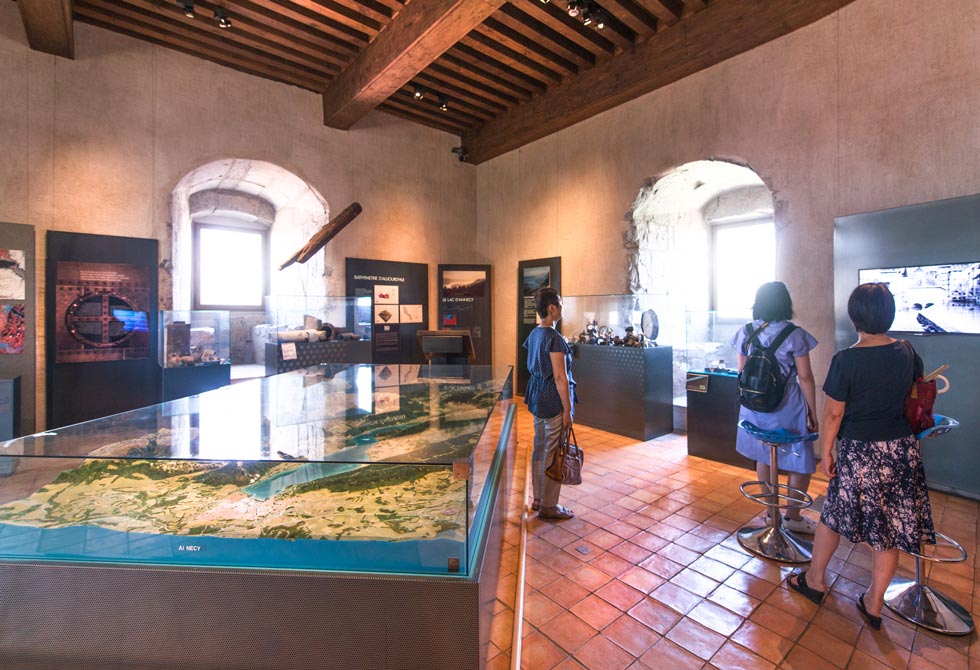
© Téo Jaffre / Alpine Lakes Regional Observatory (ORLA)
Immerse yourself in a world of blues and explore the depths of the freshwater environment, which includes sub-aquatic archeology, flora and fauna, fishing, and tourism. Through aquariums and models, films and reenactments, the museum instructs us about how to preserve this fragile environment and its rich biodiversity.
From one display to another, navigate between land and water to explore the mysteries of the area’s alpine lakes (Bourget, Annecy, Geneva).
The aquarium room showcases the species that populate our lakes: invertebrates, fish, and birds (and the Biology room “dissects” them from every angle). Next, embark on an ethnology lesson, learning how humans use lakes to fish. Did you know that at the beginning of the twentieth century, more than 500 professional fishermen worked the lakes in the area? Today, only a handful of people can make this claim.
Journey back to a world before time in the archeology section; learn about every layer of the area’s history along the shores of the major alpine lakes. Travel from the Neolithic to the Bronze age, to the prehistoric villages on stilts that formed communities along lakes and wetlands in the Alps (designated a UNESCO World Heritage site since 2011); an important record of our past.
So much water, so much history, so much to learn.
For more information: Alpine Lakes Regional Observatory
Annecy's Palais de l'Ile, Architecturally Iconic
The Palais de l’Ile is one of Old Town Annecy’s most iconic monuments. Surrounded by the Thiou River, this centuries-old structure includes what locals commonly refer to as “the old prison”.
Once you pose for the requisite photo in front of the city’s crown jewel, which did in fact once serve as a prison, as well as courthouse and administrative building, continue to the entrance to see all the history hidden inside.
Designated a Historic Monument in 1900, the Palais de l’Ile offers more than just its photogenic allure, it has transformed into an exhibit focusing on local heritage and architecture. The stone building became an official interpretive center in 2005.

© Philippe Royer / Model of the Palais de l'Ile
The perfect counterpart to the Castle-Museum, the Palais de l’Ile offers a fascinating informational and educational experience about the often little-known local setting (a “behind-the-scenes” look if you will) by highlighting the architectural and heritage resources through clear historical, ethnological, and technical explanations. This approach offers the interpretive center the opportunity to transform into the ideal location for presentations, conferences, and debates about the area’s overall urban planning strategy and current construction projects.
In its role as an educational tool for the general public, the Palais de l’Ile offers:
- A permanent exhibit to explain how the city has changed over time from its historic to contemporary architectural heritage,
- Temporary exhibits to highlight one aspect or specificity about local architecture,
- Educational youth workshops to teach how to look at and understand local architecture and heritage sites.
To put theory into practice, and to interpret your experience from ground level to skyline as you stroll through the city, guidebooks focusing on the city’s facades and Old Town offer entertaining educational tours for ages 8 and up. Explore Annecy from one architectural icon to another. Use these guidebooks to discover the city as a family.
Download the guidebook to explore the city as a family
Download the guidebook to explore the old Town
For more information: Palais de l’Ile
Visitation Basilica, stand on higher ground
Another heritage site in Annecy well worth exploring is Visitation Basilica. Perched on its pedestal high above Annecy, the church overlooks the lake and city, with fascinating vistas of the surrounding landscapes.
In the category of religious buildings, this particular basilica is relatively young. The official chapel for the Visitation monastery, construction took place from 1922 to 1930. On a side note, the Visitation Order, an enclosed religious order, was founded by François de Sales and Jeanne de Chantal, first as a congregation in 1610 before becoming an official order in 1618. Here, at this very location, the tombs of both founding saints lie.
For construction, the sponsors spared no expense, organizing a national architecture contest. Architect Alfred-Henri Recoura, a Grand Prix de Rome prize winner, was selected for the clean, simple, Neo-Romanesque style he proposed.
Recoura worked closely with a reinforced-concrete engineer to design the 72-meter high bell tower-entrance and its reinforced concrete structure.
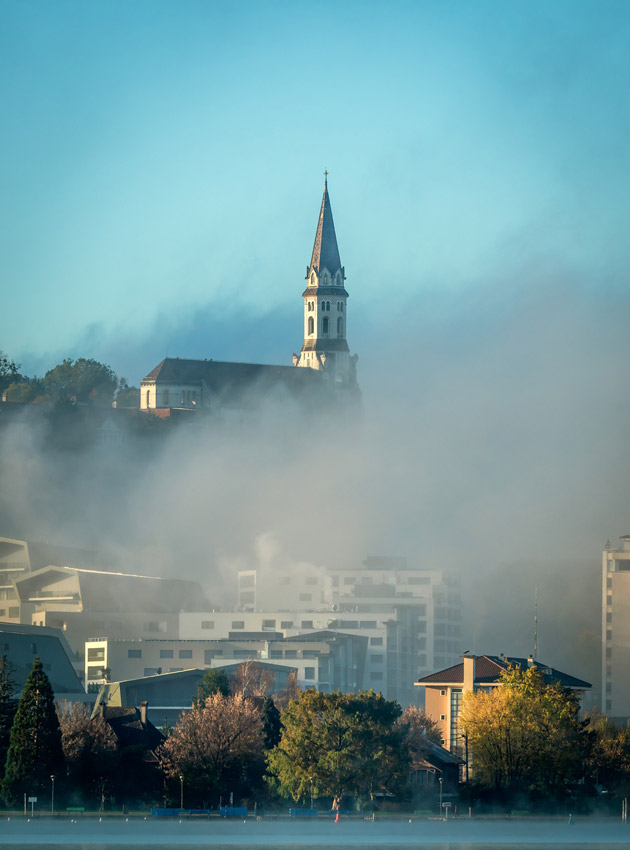
© Gilles Piel / Visitation Basilica
Inside, the décor contrasts sharply with the clean and simple exterior: the nave’s columns are made with Savoie-blue marble, the apse made with Venetian and Briare enamel, and the windows tell the story of the Visitation Order’s founding saints. The carillon contains 33 bells and was made at the Paccard foundry, located just a few kilometers away in the lakeside town of Sevrier and one of the world’s most renowned bell and carillon manufacturers.
A trip to the foundry is a well worth the detour, which we will discuss later.
For more information: Visitation Basilica
The animated film museum in Annecy, a 100% local trademark
Annecy gained international renown not only from its magnificent lake, idyllic canals, and Venetian-like charm, even though that could have (or should have?) been more than enough! The International Animation Film Festival, which started back in 1960 (Is Annecy a pioneering city or what?), has largely contributed to increasing Annecy’s fame. Every year hordes of enthusiasts, specialists, and worldwide authorities on moving pictures line up to attend conferences and screenings.
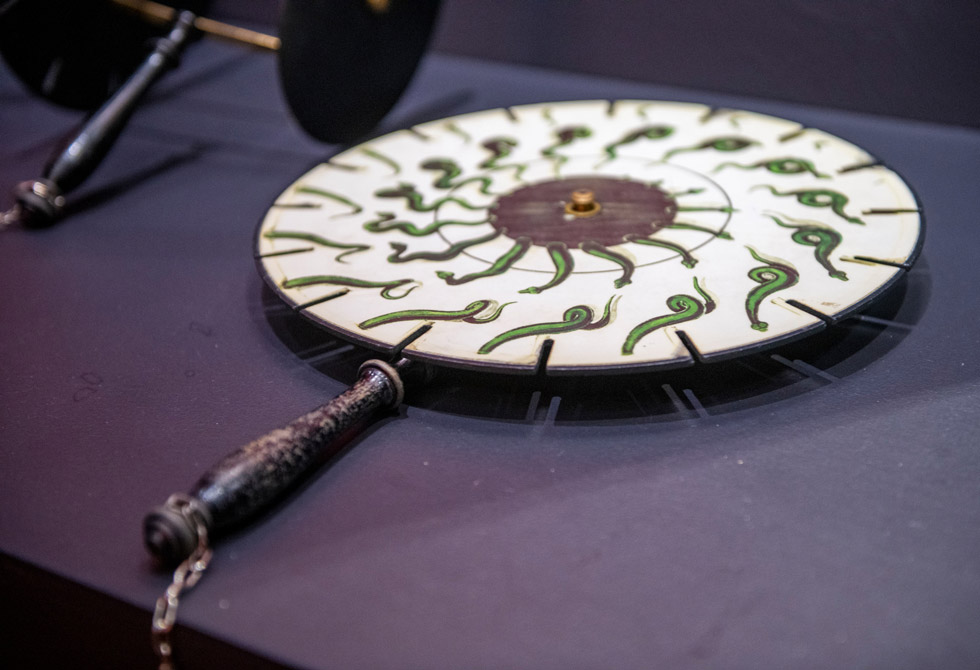
© Quentin Trillot – Ville d'Annecy
Next door to the castle, in the Art and History Conservatory building, the Animated Film Museum showcases the essence of the connection between Annecy with this amazing visual art. Through the animated film collection that the Museums of Annecy curates, including works on loan from all over the world, the Animated Film Museum offers an exciting tour through more than 6000 documents and objects. Dive deep into the animated movie creation process and uncover the secrets behind making pictures move.
From changes in technique to original creations, by way of the unique worlds of several animators, the museum offers more than a century of animated film history to explore. This distinctive form of art, while young, draws its inspiration from several centuries of artistic discovery, scientific research, and technological advances; the moving images encapsulate them to perfection.
Animation has graduated to a fundamental form of expression, one that provides insight into societal, political, and environmental issues that go far beyond the simple act of stringing several illustrations together to simulate movement.
For more information: Animated film museum
Menthon-Saint-Bernard Castle, a romantic allure with stunning views of Lake Annecy
Located above the east shore of the lake, just a dozen short kilometers from Annecy, Menthon-Saint-Bernard Castle appears to be straight out of a Walt Disney movie, with its elegant allure and towering position high above the lake waters.
Like a mythical vision, you can see it from afar, proudly standing on its rocky bluff: the rich history within proves as fascinating as the lofty stone walls are beautiful. The castle’s origin dates back to the 12th century, and the same family has lived here for almost 1000 years.
Learn about the castle’s extraordinary destiny through the 23-generation family history. The castle’s architecture has changed considerably since a mason laid the first stone, transforming from a rather grim fortress to a statelier, noble-worthy residence during the Renaissance. In the 19th century, the renovations initiated by René de Menthon provided the castle with the refined, elegant look that we know today… and magical enough to serve as inspiration for the castle in Sleeping Beauty.
From room to room, the tour reveals so many unique treasures, like the furniture in the countess’s bedroom, with its incredible ornamental wood, marquetry, and Aubusson tapestry, or the library that houses more than 12,000 pre-French Revolution books. The decorations will undoubtedly catch your eye and the history is quite fascinating.
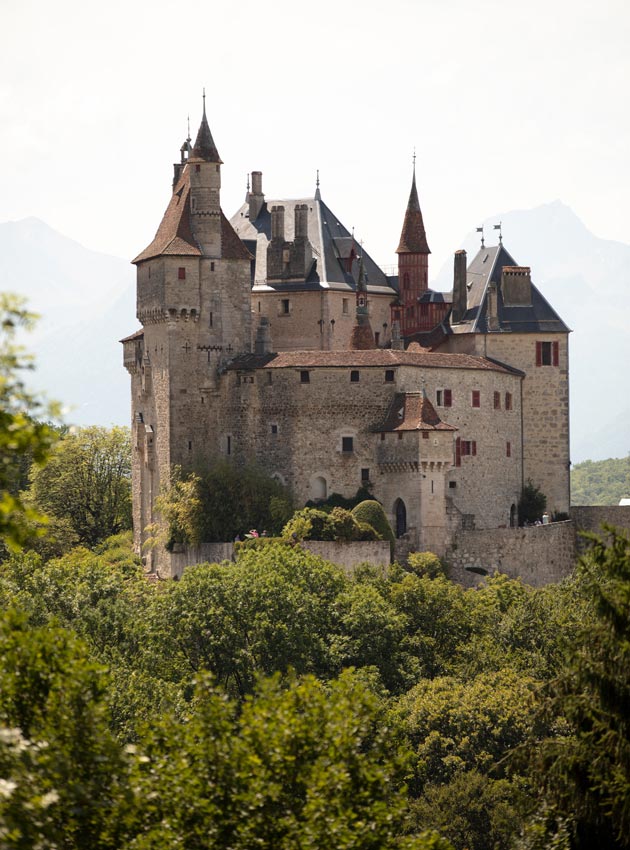
© Monica Dalmasso / Menthon-Saint-Bernard Castle
Other detours will also likely pique your curiosity. Start in the kitchen, where the architecturally stunning skylight and wood balconies are most impressive. A twenty-meter long service hallway bored straight through rock uses a tunnel and rail system to connect the kitchen to the dining room. The living room, with its ornately carved fireplace, the chapel, and the timber-framed gallery prove just as stunning.
So much history to learn and treasures to explore during a classic private or group guided tour that can be scheduled between April and the end of November. To access other more exclusive sections of the castle, “prestige” guided tours open doors to reserved, somewhat secret hallways and private areas, always ending on a delightfully delicious note with a tasting of local culinary specialties.
The vegetable garden and orchard, where aromatic and medicinal plants bask in the afternoon sunlight, as well as the recently rehabilitated vineyard covering the steep slopes beneath the castle, offer many options to create your own customized tour to explore this living historic landmark.
For more information: Menthon-Saint-Bernard Castle
Montrottier Castle in Lovagny, so majestic, so vibrant
Montrottier Castle, located on the way to Chambéry and also just a dozen short kilometers from Annecy, is a required stop for anyone visiting the area.
A National Historic Monument and official “Museum of France,” the history of Montrottier Castle, centrally and strategically located in the “Savoyard state,” dates back to the 13th century with the construction of the religious tower. Today, a pentagonal fortress surrounds the daunting cylindrical 15th century guard tower, and throughout each era of the castle’s rich history, one magnificent piece after another was added the structure’s already impressive architecture. Originally a military outpost, the castle transformed into a residence that an entire string of nobles called home, from County Amadeus III of Savoie to the Menthon family to Léon Marès, the latter a fervent collector who bequeathed the castle and its magnificent collections to Florimontane Academy in 1916.
Visiting Montrottier Castle is like opening a cabinet of curiosities containing many different wonders: music, games, clothing, military artifacts, and table arts. It is like taking a trip through time and across cultures.
From April to November, peruse a rich collection of artifacts from every corner of the planet, including several beautiful pieces from the Far East. The hall of knights contains an impressive collection of rifles, swords, crossbows, and daggers, as well as beautiful tapestries that depict fox, wolf, wild boar, jackrabbit, and buck hunts.
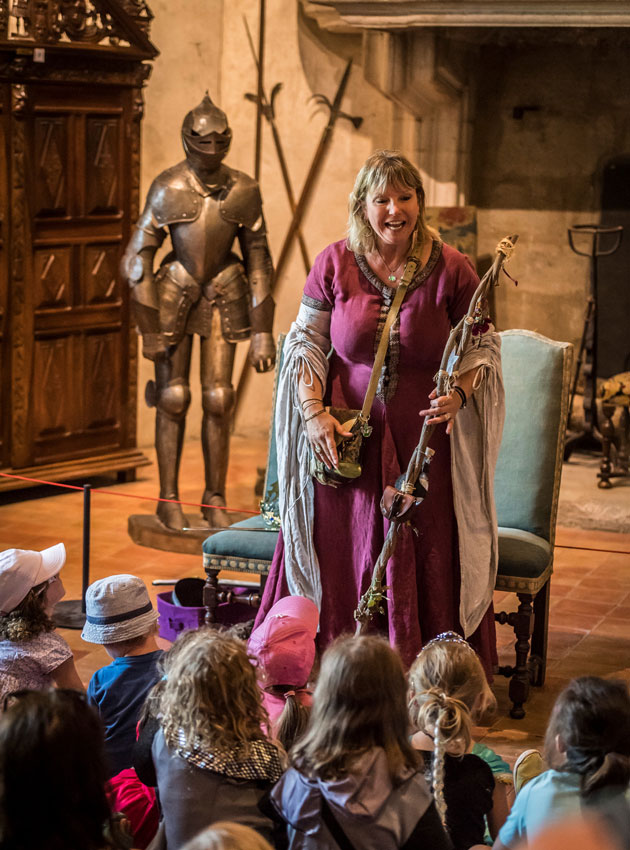
© Sémaphore – P. Leroy / Medieval show at the Château de Montrottier
The tin-glazed ceramics, bronze, and lace rooms highlight the region’s traditional know-how and expertise, while the 12th century cabinet and the Frèrejean room showcase furniture from different eras.
Ideal for families, Montrottier Castle offers a variety of fun ways to learn about the area’s history and explore the depths of the castle: embark on a treasure hunt or play an escape game throughout the season. During the 2021 All Saints’ Day holidays, in addition to the tour and treasure hunt, enjoy and crafts workshops and listening to Elaéra’s frightening tales.
For more information: Montrottier Castle
Glières Plateau, in the footsteps of the Resistance
Glières Plateau, located just 45 minutes from Annecy and above Thorens-Glières, is recommended for anyone interested in understanding the recent history of the Haute Savoie. Walking the trails of this historic location means traveling back through time to the Second World War.
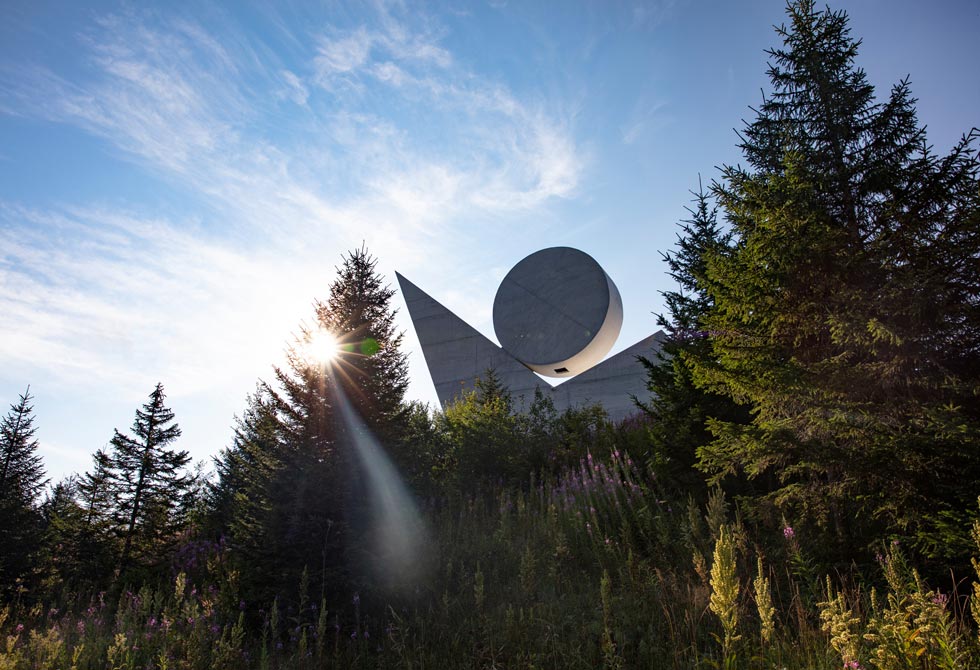
© Monica Dalmasso / The Glières Monument
In March 1944, the Resistance fighters who used Glières Plateau as their hiding spot distinguished themselves and made their mark in history in the most courageous way possible. On March 26, almost two months after the resistance movement was formed by the Secret Army, led by soldiers from the Mountain Division’s 27th battalion in Annecy under Lieutenant Tom Morel’s and then Captain Anjot’s leadership, set up base on Glières Plateau. On this very day, during the winter cold, fighting reached its peak; the Resistance (aka “Maquisards”) on one side – barely 500 brave souls – and the Vichy and Wehrmacht armies on the other. The 105 combatants who perished in the fighting are buried at the Glières National Cemetery located in the valley in the town of Balme-de-Thuy on the road to Thônes.
When visiting Glières Plateau, a beautiful and vast semi-wilderness above the Borne River Valley at 1400 meters elevation, there are several ways to immerse yourself in the area’s rich history:
- Introduction to the history of the Resistance: on this walk, learn about the daily lives of Resistance fighters.
- The Resistance National Historic Monument: created by artist Emile Gilioli and inaugurated in 1973 by André Malraux, it is an integral part of Glières Plateau’s identity. A symbolic work of art that represents the V in victory, but with one stem broken… the price of victory. The solar disk placed on top of the V represents a sign of hope.
- The Maquis Remembrance Museum: through temporary exhibits, photos, and archived documents, this museum continues to keep the memory of the Resistance alive.
- Activities, guided tours, films add to the experience to better understand the meaning and impact of this important part of history.
To plunge even further into the history of the Resistance, visitors should combine a tour of Glières Plateau with a trip to Glières National Cemetery in Morettes (Balme de Thuy), where the Resistance and Deportation Museum is also located. Enough subject matter for a truly moving, and unforgettable experience when learning about this part of history whose motto, “Live free or die,” held true meaning for every fighter in the Resistance.
A designated Sensitive Natural Area and an official Natura 2000 site, Glières Plateau is well known for its incredible plant and animal biodiversity. This translates into a great place to enjoy a wide variety of outdoor sports, both summer and winter, through a vast network of trails for hiking, snowshoeing, and cross-country skiing.
For more information: Glières Plateau
Important news to dive deeper into Lake Annecy's history and heritage
The free app ViAnnecy is your best friend if your goal is to stay up-to-date on the latest and greatest goings on around Lake Annecy.
Exploring local history and culture along the Thiou River
When it comes to history and culture, two new walks along the Thiou River add to the long list of sites to explore.
- Heritage walks: the Thiou River in Annecy
This 1.6km walk leads you along the iconic canal that funnels the Thiou River through Old Town. Enjoy the 8 sections of this very easy route to explore the Annecy of today and yesteryear; start at old Les Marquisats chocolate factory and finish the tour at Saint-Etienne du Pont-Neuf church at the city limit of Cran-Gevrier. - Heritage walks: industry and the Thiou River
Following the footsteps of the first walk, this leisurely stroll leads you deeper into Annecy’s industrial past. For 5.6km, from the Mandallaz neighborhood to the footbridges leading into Cran-Gevrier, the 7 sections of this walk offer the chance to experience the city’s industrial history as you make your way from cheese factories, to a slaughterhouse, packaging factory, loom mill, paper factories, and foundries. This vast expertise from an illustrious past makes Annecy the vibrant city it is today.
Please note: Both walks were created by the City of Annecy’s team of “City of Art and History” certified tour guides – certification awarded by the Ministry of Culture.
For more information: Walks in the old town
Museum amusement in Annecy
Through a full program of temporary exhibits, entertainment, and new activities, the museums in Annecy – the Museum-Castle, Palais de l’Île, and Animated Film Museum – reinvent themselves every season to showcase their spectacular collections.
This fall, enjoy viewing exhibits on the following themes:
- At the Museum-Castle, the “Pietà” exhibit focuses on sculpted representations of the Pietà Virgins made in Savoyard workshops toward the end of the Middle Ages, and “Bonjour l’Animation” (Hello Animation) takes visitors through 60 years of animated films.
- At Palais de l’Île, enjoy the “Turtulaine (barrel organ)” by Dominique de Beir.*
- At the Animation Film Museum, view the history of “Animated Animals” through a rather eclectic book of beasts.
Good to know: From October to May, on the first Sunday of the month, admission is free to the Museum-Castle and the Palais de l’Île and the Museum of Animated Film is open.
For more information and the latest news on the museums in Annecy:
- musees.annecy.fr – « Nouveautés » (“What’s new”) page
- Facebook « ChateauAnnecy » and « MuseeFilmAnimation »
Another story
Copyright :
- © Téo Jaffre / Annecy’s Museum-Castle
Journalist : Gaëlle Tagliabue
Translation : Darin Reisman
